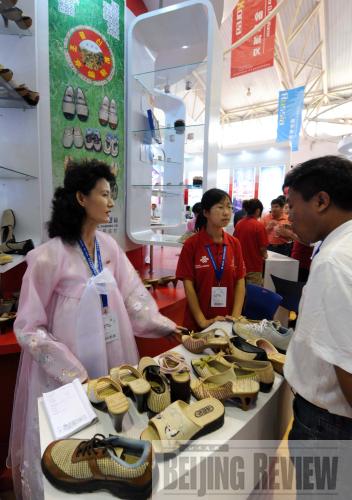|
 |
|
SEEKING OPPORTUNITIES: A saleswoman introduces products from the DPRK to visitors. More than 20 DPRK enterprises attended the Fifth China Jilin Northeast Asia Investment and Trade Expo held on September 1-6 in Changchun (YAO QILIN) |
Rising in the Changbai Mountain of Jilin Province and flowing throughout China, the Democratic People's Republic of Korea (DPRK) and Russia into the Sea of Japan, the 525-km-long Tumen River is located at the epicenter of northeast Asia.
Comprising east Russia, northeast China, Japan, the Republic of Korea (ROK), the DPRK and Mongolia, Northeast Asia, with a population of more than 600 million, has developed into an area of interest due to its rich resources and vast markets.
As early as 1991, the United Nations Deve-lopment Program initiated a discussion among northeast Asian countries to cooperate in the economic development of the Tumen River region.
In December 1995, the governments of the DPRK, China, the ROK, Mongolia and Russia signed the Agreement on the Establishment of the Consultative Commission for the Development of the Tumen River Economic Development Area and Northeast Asia. Yet, despite various attempts and efforts, the past 18 years have seen little development in the Tumen River region. In response to the stagnant situation, China has vowed to make a breakthrough.
On August 30 this year, the State Council approved the Changchun-Jilin-Tumen Pilot Area for development and opening. The new initiative has upgraded the development of the China Tumen River region to a national strategy, said the Governor of Jilin Province Han Changfu at the Fifth China Jilin Northeast Asia Investment and Trade Expo held on September 1-6 in Changchun, the provincial capital.
Seizing the Day
Located just 15 km from the Sea of Japan, Hunchun in Jilin Province, lies 850 km west of Niigata, Japan. The city is also the nearest point in China to the east coast of the ROK, to the west coast of Japan and North America, and to parts of Northern Europe.
This May, the China-Russia-ROK-Japan joint rail-port transportation route was formally launched. With a total length of 800 nautical miles, the whole route can be completed in as little as one day and a half.
Hunchun is half the distance between the more prominent port of Dalian, in Liaoning Province, and Japan, allowing companies that utilize the new trade route to save one third of the time, as well as 30-40 percent of the shipping costs, said Deng Kai, an official of the Yanbian Korean Autonomous Prefecture.
While offering the potential for a new window for trade with Japan, Hunchun's opening lagged behind its intended development. By the end of 2008, Japanese-invested enterprises in Dalian had numbered 3,700, while Jilin Province had only registered 264 such enterprises by the first half of 2008.
The Hunchun Industrial Park for Japan, Russia and the ROK has since been established to entice businesses to bring their operations to Jilin. The launch of the joint rail-port transportation route will additionally enhance the development of the industrial parks, said Feng Yuhua, Vice Mayor of Hunchun.
| 